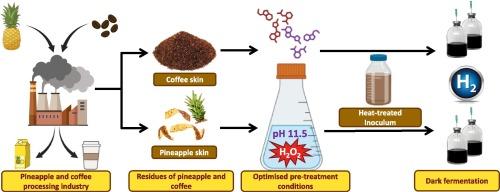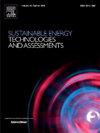利用非洲木质纤维素残渣高效生产生物氢
IF 7.1
2区 工程技术
Q1 ENERGY & FUELS
Sustainable Energy Technologies and Assessments
Pub Date : 2024-11-07
DOI:10.1016/j.seta.2024.104060
引用次数: 0
摘要
利用有机废弃物进行暗发酵生产生物氢是一项很有前途的技术,有助于实现能源转型和绿色经济。遗憾的是,由于必须对多个参数进行微调,因此 H2 的生产仍然受到限制。本研究旨在开发一种将非洲木质纤维素残渣转化为 H2 的高效工艺。我们开发了一种碱性 H2O2 预处理咖啡和菠萝皮的方法,咖啡和菠萝皮是许多非洲国家产生的大量废物。目的是在温和的条件下获得单糖,以促进 H2 的生产。原料经预处理后,在两种 pH 值(5.5 和 6.0)下通过热处理接种物转化为 H2。结果表明,在最佳 pH 值为 6、H2O2 浓度为 1.25% 的条件下,咖啡皮和菠萝皮能高效转化为 H2(分别达到 47.99 mL/gVS 和 91.80 mL/gVS)。这种组合方法取得了成功,为非洲国家优化废物流的 H2 生产处理提供了一条可行的途径。这将有助于实现联合国(UN)的 "2030 年议程",即绿色能源和可持续经济增长。本文章由计算机程序翻译,如有差异,请以英文原文为准。

Efficient production of biohydrogen from African lignocellulosic residues
Biohydrogen by dark fermentation using organic wastes is a promising technology towards energy transition and green economy. Unfortunately, H2 production is still limited as several parameters must be finely tuned. This study aims at the development of an efficient process to convert African lignocellulosic residues into H2. An alkaline H2O2 pre-treatment of coffee and pineapple skins, which are hugely produced as waste in many African countries, has been developed. The goal was to get simple sugars, under mild conditions, to foster H2 production. Once pre-treated, the feedstocks were converted by a heat-treated inoculum into H2 at two pH values (5.5 and 6.0). The results indicate that coffee and pineapple skins were efficiently transformed into H2 (up to 47.99 and 91.80 mL/gVS, respectively) at an optimal pH of 6 with a concentration of 1.25 % H2O2.
These results proved that H2O2 pre-treatment and the fine tuning of pH can be the key drivers to boost H2 production of lignocellulosic matrices. This combined approach performed successfully and stands for a promising way towards the optimization of the H2-producing processing from waste streams also in African countries. This will contribute to the United Nation (UN)’s ‘Agenda 2030’ for green energy and sustainable economic growth.
求助全文
通过发布文献求助,成功后即可免费获取论文全文。
去求助
来源期刊

Sustainable Energy Technologies and Assessments
Energy-Renewable Energy, Sustainability and the Environment
CiteScore
12.70
自引率
12.50%
发文量
1091
期刊介绍:
Encouraging a transition to a sustainable energy future is imperative for our world. Technologies that enable this shift in various sectors like transportation, heating, and power systems are of utmost importance. Sustainable Energy Technologies and Assessments welcomes papers focusing on a range of aspects and levels of technological advancements in energy generation and utilization. The aim is to reduce the negative environmental impact associated with energy production and consumption, spanning from laboratory experiments to real-world applications in the commercial sector.
 求助内容:
求助内容: 应助结果提醒方式:
应助结果提醒方式:


